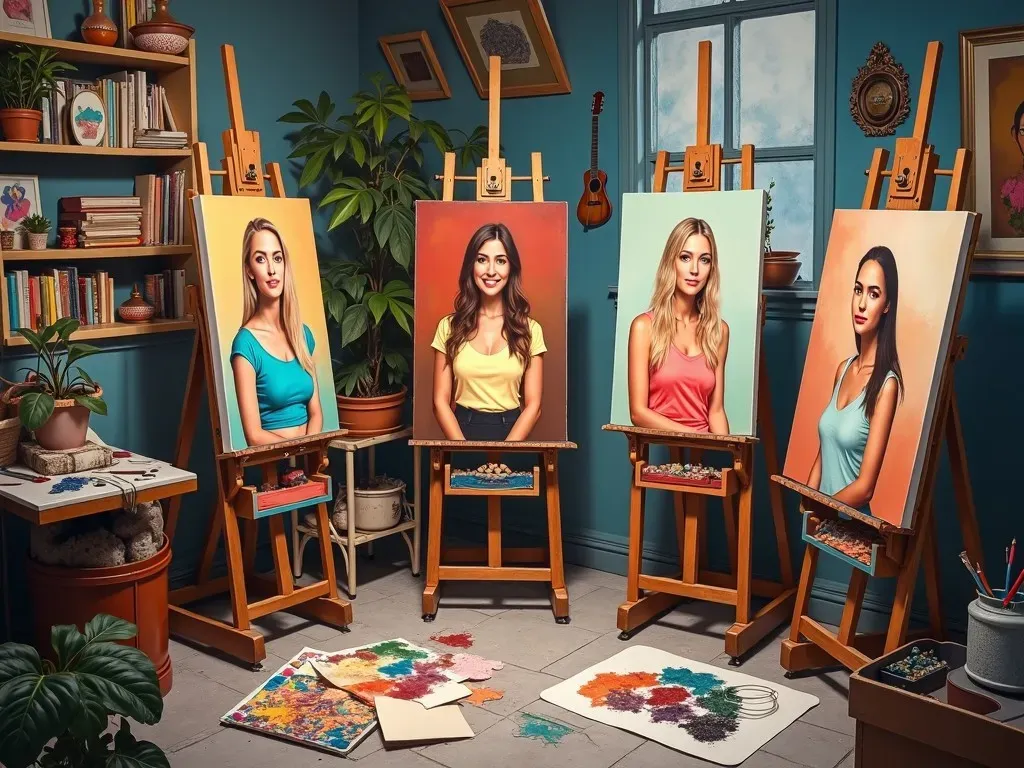Easy Painting Portraits
Painting portraits can seem daunting, especially for beginners. However, with the right Techniques, materials, and a little practice, anyone can create beautiful and expressive portraits. This article focuses on various methods and strategies for easy painting portraits, catering to those starting their artistic journey or seasoned artists looking for tips to simplify their process.
The Basics of Portrait Painting
To begin with, understanding the fundamentals of portrait painting is crucial. A good portrait captures not just the likeness of the subject but also conveys their personality and emotion. Here are some essential elements to look out for:
-
Composition: Positioning your subject effectively within the frame is vital. The composition should guide the viewer’s eye and provide balance.
-
Proportions: Capturing the correct proportions of the face is essential to create a believable likeness. The average human face can be broken down into thirds:
- The top third: Hairline to the eyebrows
- The middle third: Eyebrows to the bottom of the nose
- The bottom third: Bottom of the nose to the chin
Facial Features Average Proportions Hairline to Eyebrows 1/3 of total face height Eyebrows to Nose 1/3 of total face height Nose to Chin 1/3 of total face height -
Color Theory: Understanding how different colors interact can enhance the mood and impact of your portrait. For skin tones, it’s important to mix colors carefully, often achieving a natural look by blending warm and cool tones.
Essential Tools for Easy Painting Portraits
Having the right materials on hand can make painting portraits easier and more enjoyable. Here’s a curated list of essential tools:
- Paints: Acrylic paints are a great starting point as they dry fast and are easy to work with. Oil paints can also be used for more depth and richness in color.
- Brushes: A variety of brushes will allow for different effects. Flat brushes are ideal for broad strokes, while round brushes work well for detailing.
- Canvas or Paper: Choose a surface that aligns with your painting medium. Canvas is great for oils, while acrylics can be used effectively on both canvas and thick paper.
- Palette: A palette for mixing colors is crucial. You can use a disposable palette pad or a traditional glass palette.
- Easel: While not mandatory, having an easel helps with a comfortable working position and better control.
Techniques for Easy Painting Portraits
Here are some techniques that simplify the portrait painting process:
1. Block-In Method
Start by blocking in the basic shapes and colors of the face. Use a large brush and thin paint to quickly cover the canvas, which allows you to establish composition and overall colors without getting caught up in details.
2. Layering
Building up layers of paint not only adds depth but also helps adjust your colors and shapes as you progress. Begin with an underpainting, which is often a monochrome or neutral color, and then layer on skin tones and details.
3. Glazing
This technique involves applying a thin, transparent layer of paint over a dried layer to achieve luminosity. Mix a small amount of paint with a glazing medium to create the desired effect.
4. Use of Reference Images
Utilizing reference photos can greatly aide in capturing likeness. Ensure you select high-quality images with good lighting. Multiple angles can help you understand the form and structure of the subject’s face.
Portrait Painting Techniques for Beginners
Step-by-Step Guide:
- Select Your Subject: Choose someone comfortable in front of the camera or a photograph that inspires you.
- Set Up Your Workspace: Ensure good lighting and organization of your materials to avoid distractions.
- Sketch the Outline: Lightly sketch the figure’s features on your canvas. Use guidelines to help maintain proportions.
- Start Painting: Use a larger brush to block in the main colors first before moving on to smaller brushes for details.
- Refine and Detail: Gradually add more details and refine the features and texture of the face.
Helpful Resources: For a comprehensive guide on how to paint portraits from photographs, check out this helpful article on Empty Easel.
Quick Portrait Painting Tips
- Practice regularly: As with any skill, continuous practice is key to improvement.
- Study real faces: Spend time observing faces in different lights and positions to enhance your understanding of proportions and colors.
- Keep it simple: Don’t overwhelm yourself—start with basic portraits and gradually incorporate more complexity.
FAQ
Q: Do I need to have prior painting experience to create easy painting portraits?
A: No prior experience is required! The tutorial is designed for beginners, and practice will help you improve.
Q: What are the best colors to use for skin tones?
A: A mix of warm and cool colors such as yellow ochre, cadmium red, titanium white, and burnt sienna typically yield pleasing skin tones.
Q: Can I paint portraits using digital tools?
A: Yes! Digital painting software offers a versatile platform for portrait creation, allowing for easy adjustments and layers.
Q: How long does it take to learn portrait painting?
A: This varies by individual. Regular practice and study can lead to significant improvement within months.
Q: Can I paint over a failed portrait?
A: Absolutely! Painting over old canvases is common and can help you learn from previous attempts.
Further Learning Resources
If you’re eager to continue your learning journey, consider the following articles:
- How To Paint A Portrait In Acrylic For Beginners
- How to Paint a Portrait: 38 Portrait Painting Tips
- 101 Cute & Easy Acrylic Painting Ideas for Beginners on Canvas
Remember, every artist starts somewhere. Embrace your unique style and enjoy the process of creating easy painting portraits!
